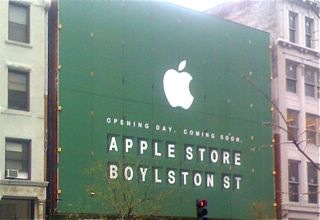
Today's Note From Anywhere is inspired mostly by the Green Monster sign outside our office noting the opening of the world's largest Apple Store here in Boston next week.
Elementary economics says that you build volume by cutting prices on products. But Apple's latest 10-Q filing, where it provided details of its latest record-breaking sales quarter, has a nice counterexample to that so-called wisdom. You have to dig a bit to find it, but look for page 23 of the 10-Q, which has a table titled "Net Sales". But if you don't want to look at the original, here are the lines that are of interest:
| Three months ended 3/31/2008 | Three months ended 3/31/2007 | Change | |
| Net Sales By Product | |||
| Desktops | $1,352 | $914 | 48% |
| Portables | $2,142 | $1,354 | 58% |
| Unit Sales By Product | |||
| Desktops | 856 | 626 | 37% |
| Portables | 1,433 | 891 | 61% |
| Net Sales Per Mac Sold | |||
| $1,526 | $1,495 | 2% | |
So let's walk through this line by line. Between 2007 and 2008, desktop Mac revenues increased 48% while portable Mac revenues increased 58%. At the same time, desktop units sold increased 37%, while portable unit sales went up 61%. And the average net sale per Mac? Despite the fact that Apple was selling many more desktops and notebooks, the average net dollar amount sold per Mac increased 2%. Said another way, despite the fact that consumers paid 2% more per unit, consumers bought nearly 50% more Macs year over year.
Now the sharp-witted readers will note that this increase in average selling price can be explained nicely by the fact that Apple sold more notebooks than desktops. Since notebook computers have slightly higher selling prices, that change in product mix almost entirely accounts for the increase. But even so, average selling prices for desktops went up year over year, not down. And if you look at the original 10-Q filing, you'll note that average net sales for iPods went up as well, almost certainly driven by iPod touch sales.
So what's the takeaway here? It's that innovation and marketing -- creating unique products that customers want -- trump price elasticity with consumers. The elementary economic wisdom that you increase volume by cutting prices assumes that you are selling a commodity. Apple isn't selling commodities; it is selling differentiated products that only it makes. And that means that Apple's economic model is one that is anything but elementary.
